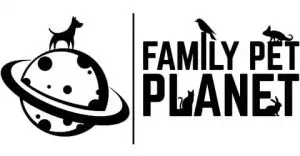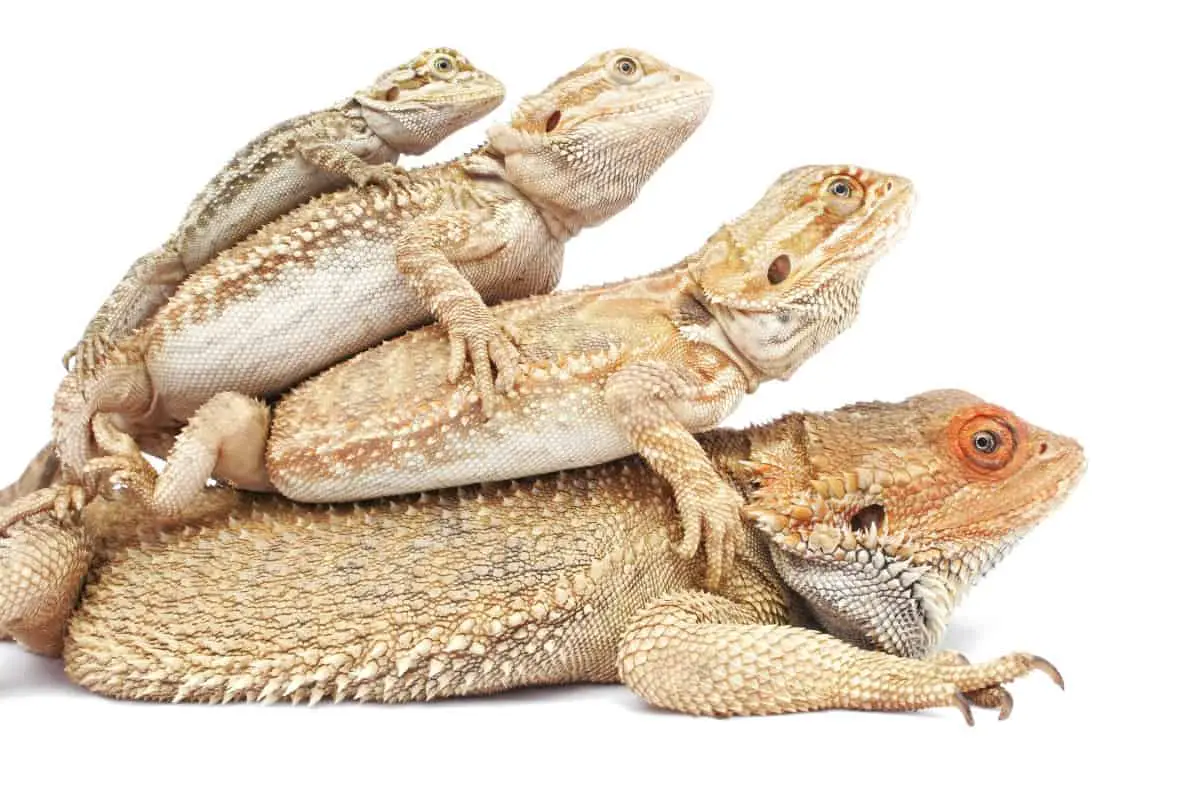Affiliate Disclosure: This post may contain affiliate links. If you make a purchase after clicking on these links I will be compensated at no extra cost to you. However, I never recommend anything I don’t love or wouldn’t use myself!
Before taking the plunge and buying a bearded dragon, it’s good to know just how big they can grow eventually. It can be easy to underestimate just how big of an enclosure you will need, particularly when you see the little guys in the store. So…
How big and how fast do bearded dragons grow? The Pogona Vitticeps or Central Bearded Dragon is the most common bearded dragon kept in the United States and can grow to a maximum of 24 inches long. Bearded Dragons generally grow to around 11 inches long within the first three months, then 1-2 inches every month thereafter, slowing to 1-2 inches growth in the entire second year.
Your bearded dragon’s growth will be gradual and may catch you by surprise when one day you look at it, and it’s suddenly almost two feet long! Nonetheless, there are a few factors that can impact your bearded dragon’s size and growth rate that you should probably know.
Bearded Dragon Growth Rate
As alluded to above, bearded dragons tend to grow rapidly within their first few months of life and then the growth rate slows dramatically in the following months.
You can expect your bearded dragon to be almost fully grown within their first year, while they may only grow as little as one or two inches in total for their entire second year.
The following chart shows the average growth rates of 50 bearded dragons during their first year of life.
| Bearded Dragon Length | Bearded Dragon Age |
| 3-4 Inches | 0-1 Months |
| 5-9 Inches | 2 Months |
| 8-11 Inches | 3 Months |
| 9-12 Inches | 4 Months |
| 11-16 Inches | 5 Months |
| 11-18 Inches | 6 Months |
| 13-20 Inches | 8 Months |
| 16-24 Inches | 12 Months |
These figures give you a good idea of what to expect when it comes to the speed at which your bearded dragon will grow.
When Do Bearded Dragons Stop Growing?
Beardies will usually stop growing before they reach the two-year mark. Depending on their growth rate, they are usually considered adults at around 12-18 months.
These are just guidelines. Some owners have reported their bearded dragons to have reached a healthy adult size at as young as 8 months old!
Factors For Bearded Dragon Growth Rate
There are different factors you should take into consideration when it comes to bearded dragon size and growth rate, such as:
- Species
- Gender
- Diet
- Habitat
- Lighting
- Disease and Parasites
Let’s investigate how some of these different factors affect a bearded dragon’s size and how to ensure your bearded dragon reaches it’s naturally intended stature.
Stunted growth generally results from poor quality of life and can also impact a bearded dragon’s lifespan. The good news is that aside from the top two on the list, we as owners have control of most of these factors.
8 Species of Bearded Dragon (Pogona) and Their Sizes
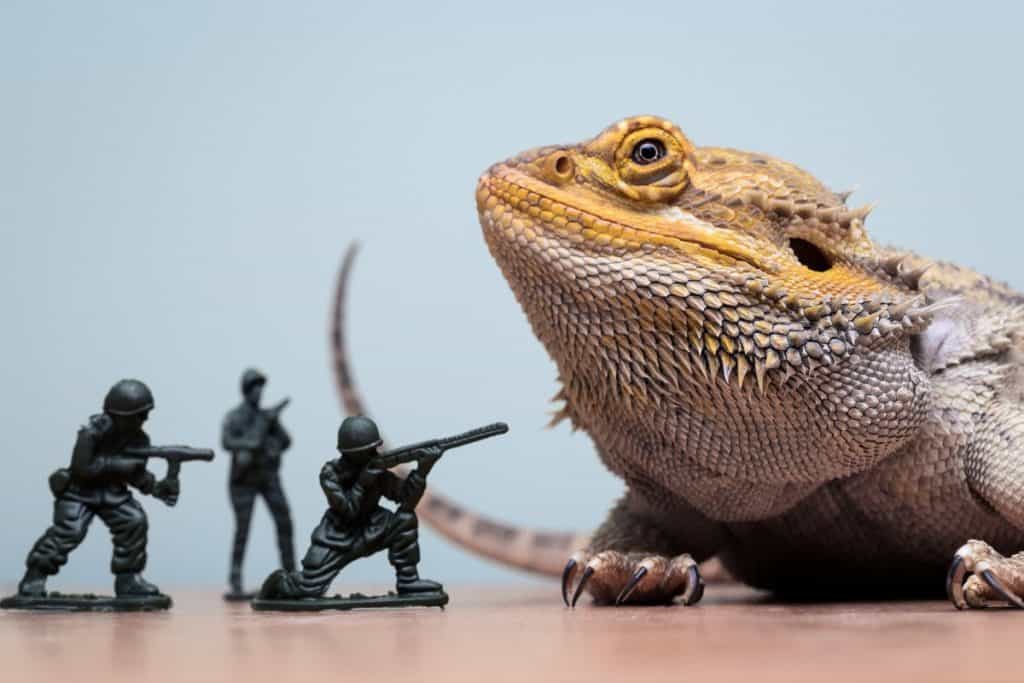
First of all, to accurately chart your lizard’s growth, it’s important to know which species you’ve acquired. Here are the eight known species of bearded dragons and how they vary in size and availability.
1. Pogona Microlepidota – The Drysdale River Bearded Dragon is the smallest at 4-6 inches in length and is very rare. They are usually found in coastal and woodland areas.
2. Pogona Henrylasoni – Lawsons Bearded Dragon will only get up to 12 inches long. These dragons are known for their:
- Daytime activity
- Love of climbing more than anything
- Natural habitat of dry, rocky, arid areas – deserts
3. Pogona Minor Minima – Also called the Western Bearded Dragon is very rare and only grows up to 12 inches. These dragons are usually found in dry woodlands.
4. Pogona Nullabor – Also rare, the Nullabor Bearded Dragon grows up to 14 inches long. These lizards prefer flat brush environments.
5. Pogona Minor – More commonly known as the Dwarf Bearded Dragon, it grows up to 14-18 inches and is also very rare. It prefers rocky areas and woodlands.
6. Pogona Minor Mitchelli – This rare lizard is called Mitchells Bearded Dragon and can reach up to 18 inches long. These rare dragons are usually found in semi-tropical woodlands and the desert.
7. Pogona Barbata – The Coastal or Eastern Bearded Dragon grows up to 24 inches. These are known for:
- Being very territorial around other dragons
- Being active during daytime hours
- Being found in dry, wooded areas
- Climbing and running along the ground
8. Pogona Vitticeps – The Central Bearded Dragon is the most common and most popular and will get up to 24 inches long. This is the type of bearded dragon owned by most bearded dragon lovers in the United States. These lizards:
- Are known for their gentle nature
- Are indigenous to dry brush environments, forests, and deserts
- Are awake during the day
- Enjoy climbing
In the same way that dogs have often been bred to emphasize certain characteristics, there are a host of hybrid bearded dragons that have been specifically bred to enhance their color – red, yellow/gold, orange, and white. A natural bearded dragon will usually have some mixture of green, yellow, red, and tan.
Bearded Dragon Gender Size Differences
As with most animals, there are definitely size differences when it comes to bearded dragon gender. If you compare a male and female bearded dragon of the same species you should notice a few things.
Firstly, male bearded dragons tend to grow longer (from head to tail) than their female counterparts. If you take the Pogona Vitticeps for example, they have a size range at 12 months of approximately 16-24 inches. Typically you can expect the males to lean nearer the upper limit of 24 inches, and the females to be more towards the 16-inch mark.
Whilst females may not be as long as males, they actually have a broader body, generally speaking. The female’s tail, on the other hand, tends to be more slender than the males. Males typically also have larger heads than females.
Gender Identification
While there are some clear differences when it comes to male and female bearded dragons, some people may suggest that you can identify the sex of your bearded dragon based purely on its size or even certain behavioral traits.
Unfortunately, neither of these are completely reliable methods as each dragon is different and you may even have two different species of lizards that look very similar to one another.
Instead, once your bearded dragon is an adult (8-12 months old), you can tell the gender difference by looking at its underside. The male will have two bumps called hemipenile bulges above the vent/slit between his back legs. The female will have a single bump behind the vent/slit on her tail.
Male shown on the left vs Female shown on the right.
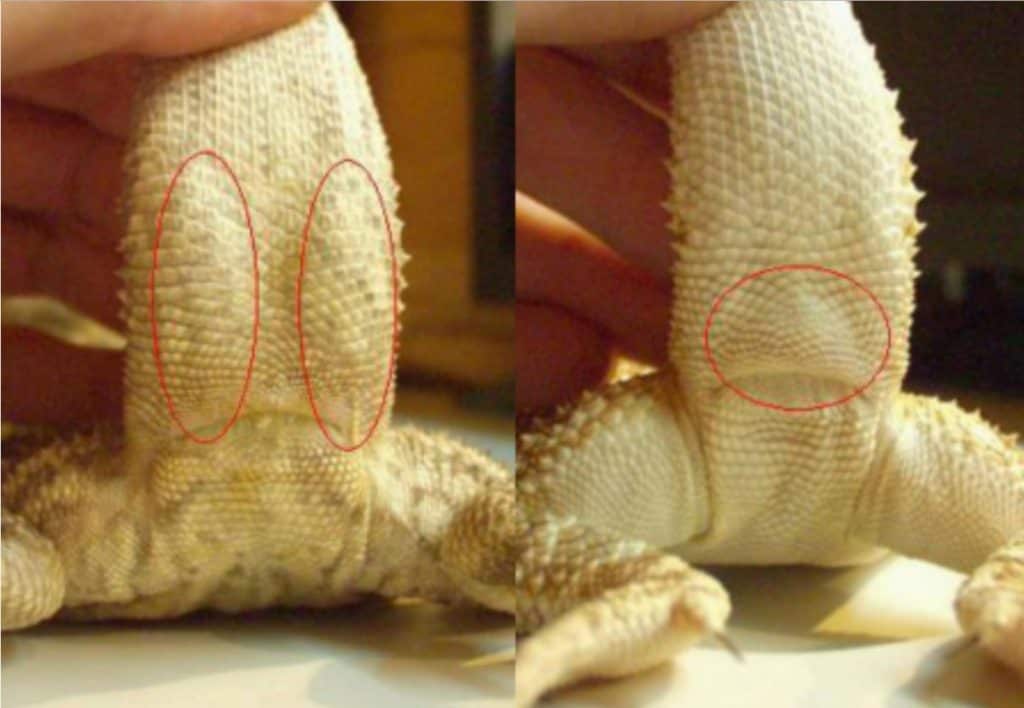
Note that all young bearded dragons will appear to be female until they reach sexual maturity.
How Dominance Can Affect a Bearded Dragon’s Growth
It’s not advisable to keep multiple dragons in the same tank together and for good reason, even if they are both females, which are the less dominant sex of the species.
Keeping more than one bearded dragon in the same enclosure will almost always result in a struggle for dominance. Unfortunately, in this case, you will find that the more dominant lizard will end up on top, quite literally…
If you see one bearded dragon on top of the other, it may seem as though they are being affectionate with one another. In reality, they are most likely fighting for the best lighting spot and the more dominant will always win. This means that the less dominant lizard may not receive all of the UVB that it needs for healthy bone growth.
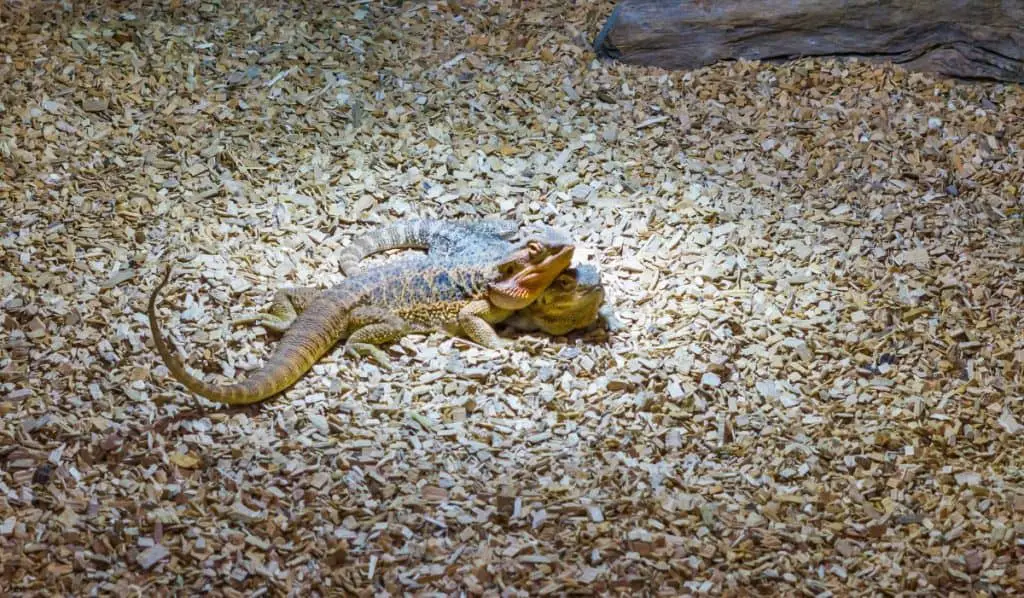
The more dominant bearded dragon will end up with the lion’s share of the food as well if you are not careful. Many owners who keep more than one dragon in the same tank together will feed them separately because of this. However, this is still not a perfect solution.
Quite often, just being in close proximity to another dragon will put your lizards under a great deal of stress. This can cause them to eat less even if given the option. This is why it is always advised to house bearded dragons separately and so they are out of each other’s line of sight.
For more information on keeping bearded dragons together, check out my other article Can Bearded Dragons Live Together?
Bearded Dragon Diet for Healthy Growth
Bearded dragons are omnivorous reptiles. They love eating both plants and insects. Getting used to their dietary requirements may seem a bit complicated at first, but as you learn the routine, you will soon feel that you’re an expert ready to train other owners.
To keep your dragon’s growth on track, you’ve got to understand their dietary needs. If they aren’t getting all of the nutrients that they require they can become malnourished and will be unable to grow to healthy proportions.
It should be noted that a baby bearded dragon’s diet is different from that of an adult.
1. Baby Bearded Dragons
Many breeders recommend that people avoid buying baby lizards because they are more sensitive and susceptible to various illnesses and injuries. If you do get a baby bearded dragon, consider the following tips for their basic diet:
- Offer more insects than vegetables. A typical juvenile bearded dragon will eat between 20 and 60 crickets (or other insects) per day – depending on where it is in its growth cycle
- Feed it insects three times per day from your reputable breeder or pet store – as many as it can eat within a 10-15 minute period.
- Do not feed your baby (or adult) bearded dragon wild insects as they may carry parasites that can harm your reptile. Remove any uneaten bugs after the 10-15-minute eating period.
- Make sure the insects aren’t too big. The insects should not be any larger than the space between the lizard’s eyes. Insects that are too large for your reptile can cause it harm.
- Dust the insects with a reptile-specific calcium/vitamin D3 supplement once per day.
- Dust the insects with a multi-vitamin supplement like Herptivite twice per week
- Always leave fresh (or thawed frozen) vegetables available in their dish.
- If you spray the fruits, plants, and vegetables with water, it will help keep the food fresher and your bearded dragon hydrated.
2. Adult Bearded Dragons
Your adult reptile only needs to eat insects once per day, along with their sprayed greens. You will be able to reduce the calcium dusting to three times per week and the vitamin/mineral supplement to once per week.
Edible insects for your bearded dragon include:
- Black Soldier-Fly Larvae
- Locusts
- Cockroaches
- Zophobas
- Waxworms (as special treats)
- Silkworms
- Butterworms (as special treats)
Reminders about insect size:
- Insects offered should never be larger than the space between your bearded dragon’s eyes, or it may cause your reptile to suffer from impaction and/or hind leg paralysis.
- Leftover bugs should be removed after the 10-15-minute insect feeding period has completed.
- Obtain insects from reputable breeders or pet stores as they should be free of parasites or poisons.
Safe plants, fruits, and vegetables for your bearded dragon to eat include:
- Basil
- Carnations
- Clover
- Daylilies
- Impatiens
- Maple Leaves
- Mint Leaves
- Oregano
- Rosemary (fresh)
- Sage
- Thyme (fresh)
- Dandelion Greens
- Chives
- Rose Petals
- Strawberries
- Watermelon
- Melon
- Blackberries
- Cranberries
- Blueberries
- Plums
- Grapes
- Raisins
- Prunes
- Apples
- Figs
- Pineapple
- Cherries
- Acorn Squash
- Butternut Squash
- Collard Greens
- Endive
- Mustard Greens
- Spaghetti Squash
- Turnip Greens
- Yellow Squash
- Carrots
- Bok Choy
- Cabbage (raw)
- Cucumber (peeled)
- Bell Peppers (raw)
- Carrots
Note: All of the above fruits and vegetables are designated as safe for your bearded dragon to eat. However, you should be aware that eating too much of any particular food can be detrimental to your pet’s health as some foods may be lacking-or too rich with-a particular vitamin.
Remember a healthy diet is a varied one. If in doubt you should check with a reputable pet store or breeder for more tailored advice depending on the size and age of your dragon.
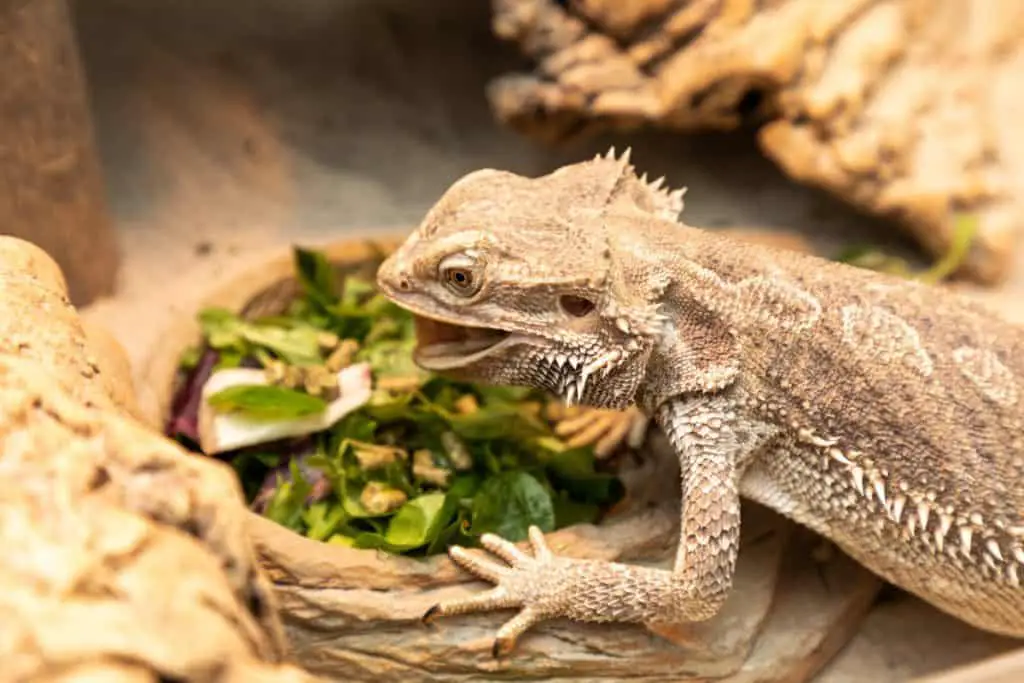
In general, leafy greens are the safest for your bearded dragon to eat on a daily basis as they contain high levels of vitamin D3 which is crucial for your bearded dragon’s growth and overall wellbeing.
Bearded dragons in captivity will often suffer from Metabolic Bone Disease (MBD) which causes their bones to become very brittle and week. Vitamin D3 helps with the absorption of calcium, which is why it is so important for them to get enough in their diets.
Do NOT feed your bearded dragon the following:
- Lettuce – any type of lettuce – it isn’t nutritious for your reptile
- Spinach – it’s difficult for your dragon to digest
- Insects captured “in the wild” (or from your backyard) – as previously mentioned, these may be hosts to parasites or have pesticides attached to them
- Fireflies or other insects that glow – these can be lethal to your bearded dragon
- Avocados – They are toxic
The following plants are among those deemed poisonous and/or unsafe for your bearded dragon:
- Amaryllis
- Angel’s Trumpet
- Azalea
- Bird of Paradise
- Buttercup
- Clematis
- Wild Daffodil
- Delphinium
- Elephant’s Ears
- Lily-of-the-Valley
- Hyacinth
- Periwinkle
- Marijuana
- Oak
- Philodendron
- Poppy
- Poinsettia
- Rhododendron
- Shamrock Plant
- Sweet Pea
- Tobacco
- Tulip
- Wisteria
Bearded Dragon Habitat for Healthy Development
One of the factors for a bearded dragon to develop and grow properly is habitat. Without the right environment, your bearded dragon may develop health issues which can lead to stunted growth.
Do Bearded Dragons Grow to the Size of Their Enclosure?
A commonly held belief is that similar to goldfish, your bearded dragon will only grow to the extent that its living space allows. However, a small enclosure is not necessarily the root cause of a bearded dragon staying small.
Stunted growth in bearded dragons is more likely a result of improper lighting, poor diet, stress, diseases, and parasites.
That said, an amply proportioned living space is easier to fit with proper lighting and to regulate the temperature inside. Being kept in a tiny enclosure can also lead to more stress which can negatively impact your bearded dragon’s health and therefore growth.
There is also something to be said regarding owners who provide a properly sized enclosure being more vigilant in other aspects of their pet’s care which facilitates the proper development of their animals.
Recommended Enclosure Size
If you have purchased, or are planning on purchasing, the most common type of bearded dragon – the Pogona Vitticeps – a 55-gallon tank should be sufficient, however, you should ideally aim for 75-gallons or larger. Your bearded dragon will thank you for it. The more room to run around the better!
Enclosure Cover
You’re pretty sure you’ve chosen your bearded dragon’s enclosure correctly, but should it have a specific type of top or lid? Yes!
Tempting as it may be, do not use glass, plexiglass, or wood to keep the top of your bearded dragon’s cage covered.
You need to have a mesh or screened top (amazon) on your lizard’s habitat. This will allow for excellent airflow, which will also help in ensuring the tank doesn’t get too humid.
Proper Lighting
To maintain light levels, you need to purchase lighting that will extend the full length of the enclosure and will replicate sunlight. There are specific lights created for reptile environments that will provide both UVA and UVB lighting. Unfortunately, these will need to be replaced nearly every 6-months.
UVB lighting, in particular, is crucial for vitamin D production in bearded dragons. Vitamin D which is critical to your lizard’s bone growth and overall health.
In addition to the light that replicates the sun throughout the entire tank, the warm end of the tank also needs to have a “basking bulb” to provide the extra heat your reptile needs for its daily sunbathing routine. (no SPF necessary!)
This basking light needs to have a bright white bulb as bearded dragons don’t seem to do well with other colors of lighting.
Ideal Temperatures
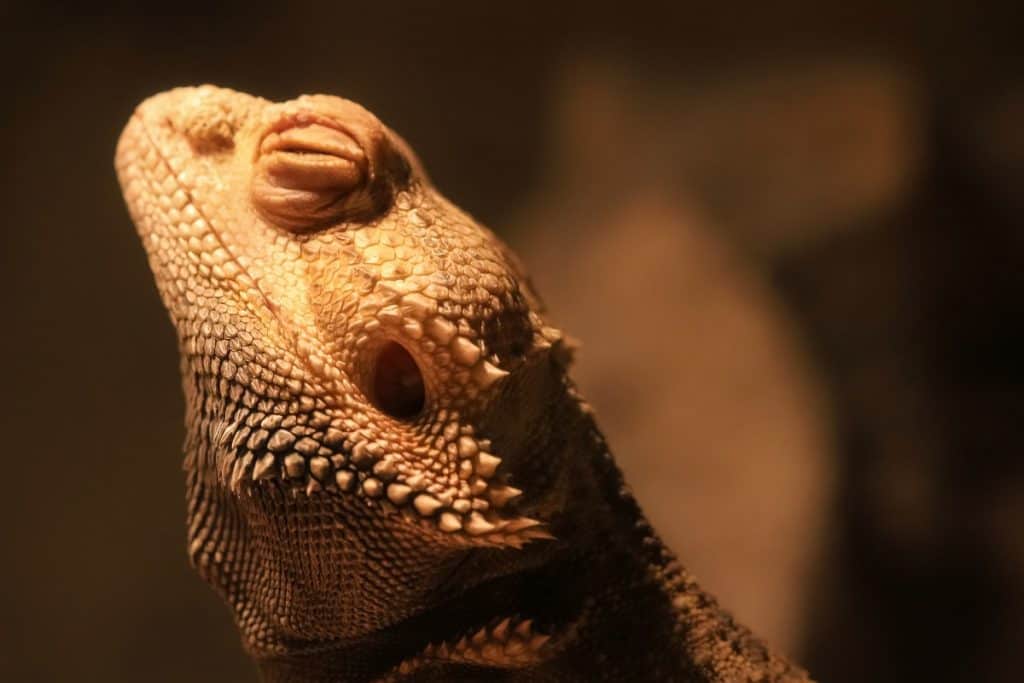
Another reason a larger enclosure is better is that you will need to have two different areas available for your pet – one side that is kept warmer during the day (between 95 and 110 degrees Fahrenheit) for “sunning” itself, and another side for it to be able to hide and retreat, that is kept at a more temperate 85 degrees.
During the night, the temperature can go as low as 65 degrees Fahrenheit, but 70-75 degrees Fahrenheit is recommended for night-time temperature.
Does that sound hot? Well, these are desert reptiles, so in that context, the temperatures make more sense. So does their need for a low humidity environment.
Thermometers and Humidity Gauges
Bearded dragon experts suggest that you invest in accurate and reliable thermometers for both the warm and cool sides of your tank to ensure you keep the tank at the right temperatures. Day and night temperature differences are important for your lizard’s health.
It is also recommended to keep a humidity gauge in your reptile’s tank to make sure the humidity stays at around 35-40 percent.
Flooring
Much like any other baby, young bearded dragons are very curious and like to taste everything. With that in mind, for young dragons, do not use:
- Sand
- Crushed walnut shells
- Shavings or any other loose substrate
Instead, use:
- Reptile carpet
- Paper towels
- Newspaper
- Butcher paper
When choosing your adult lizard’s reptile carpet, it is recommended that you choose the kind that looks and feels like grass. Avoid the kind that is more like felt – it has loops in its construction which can hook onto your lizard’s toes or nails and injure it.
While it is not advised, particularly for younger dragons, you can use sand in your adult dragon’s enclosure but you should never use crushed walnut shells as they cannot be digested
Fascinating Items of Interest
You’ll also want to provide your bearded dragon’s terrarium or enclosure with a background – especially if it is clear. This will be the first thing that you’ll do to help your lizard feel more secure.
Another thing you’ll want to add to your bearded dragon’s enclosure is what is called a “hide.” This will give your lizard a place it can go when it wants to sleep or just to get away from prying eyes. Yes, even your reptile may crave some privacy!
A Personal Playground
Your bearded dragon will also enjoy climbing on items, so get creative and give it some things on which it can play – branches, rocks, logs, even reptile hammocks. It will also enjoy climbing through artificial plants where it can explore and hide.
Your lizard will also want a basking platform – a surface that’s closer to the basking light.
More About Your Bearded Dragon’s Development
If this is the first time you’ve owned this type of pet, there are certain things to know about your lizard.
Typical Lifespan
- A bearded dragon that has been treated well and carefully cared for will typically live to be between 8-12 years old in captivity
- Bearded dragons who are in the wilds of Australia, or who are neglected by their owners typically live between 5-8 years.
- The maximum lifespan of bearded dragons in captivity as pets is 12-14 years.
- In highly unusual circumstances, there have been (unsubstantiated) reports of bearded dragons living beyond 14 years!
Shedding
Your bearded dragon is a reptile, and as such, will shed its skin. Baby/juvenile bearded dragons will shed more frequently as they grow. Adults, on the other hand, will usually only shed twice per year.
During the shedding season, it is recommended that you use a spray bottle to occasionally mist your lizard. This will keep the skin moist and help it slide off properly when ready.
In general, you should not pull the skin off of your reptile until it is at the tail and toe areas, as these are difficult for it to complete the process itself. Do NOT tug on the shedding skin – it should easily come off. If it seems to be still attached, try the next day again, and so on, until the skin slides straight off.
Prematurely peeling the skin off your bearded dragon will damage the scales on its new hide and may also do damage to its fragile extremities.
Extremity Regeneration
Unlike other types of lizards, bearded dragons are not able to regrow parts of their tails or their toes that become detached.
In Conclusion
Bearded dragons are reptiles you can own that will still offer you a level of companionship.
For first time owners, it is recommended that you do not purchase a baby dragon, but that you get one that is at least 6 months old, if not beyond its juvenile stage (i.e. older than 8-12 months).
Your bearded dragon will become accustomed to your touch and will enjoy perching on your shoulder, head, arm. But if you startle it and it starts running, good luck catching up with it – they’re very fast creatures.
There are even harnesses made specifically for lizards so you can even teach it to go on walks with you, but it’s something you’ll have to figure out how to manage. Just announcing the type of pet, you have will be more than enough to start an interesting conversation.
